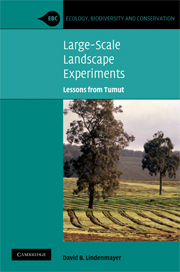Book contents
- Frontmatter
- Contents
- Preface
- Acknowledgements
- 1 The science of understanding landscape change: setting the scene for the Tumut Fragmentation Study
- 2 The theory: an overview of landscape change and habitat fragmentation
- 3 The field laboratory: the Tumut study area and the vertebrate animals it supports
- 4 Setting up the study: the design and implementation of the main cross-sectional study at Tumut
- 5 The core findings: the effects of landscape context on animals and plants
- 6 Patch use: how animals use patches of remnant eucalypt forest surrounded by pine
- 7 Theory against data: testing ecological theories and concepts
- 8 Testing PVA models with real data: melding demographic work with population modelling
- 9 Genes in the landscape: integrating genetic and demographic analyses
- 10 Refining and extending the research programme: additional studies at Tumut (and nearby) that build on the Fragmentation Study
- 11 Recommendations for plantation managers: implications for biodiversity and conservation in plantations
- 12 Lessons on running large-scale research studies: some insights from running the Tumut Fragmentation Study and directions for the future
- Appendix 1 List of collaborators/contributors to the Tumut Fragmentation Experiment
- Appendix 2 Detections of bird species in the Tumut Fragmentation Study classified by four broad classes of sites
- References
- Index
6 - Patch use: how animals use patches of remnant eucalypt forest surrounded by pine
Published online by Cambridge University Press: 20 May 2010
- Frontmatter
- Contents
- Preface
- Acknowledgements
- 1 The science of understanding landscape change: setting the scene for the Tumut Fragmentation Study
- 2 The theory: an overview of landscape change and habitat fragmentation
- 3 The field laboratory: the Tumut study area and the vertebrate animals it supports
- 4 Setting up the study: the design and implementation of the main cross-sectional study at Tumut
- 5 The core findings: the effects of landscape context on animals and plants
- 6 Patch use: how animals use patches of remnant eucalypt forest surrounded by pine
- 7 Theory against data: testing ecological theories and concepts
- 8 Testing PVA models with real data: melding demographic work with population modelling
- 9 Genes in the landscape: integrating genetic and demographic analyses
- 10 Refining and extending the research programme: additional studies at Tumut (and nearby) that build on the Fragmentation Study
- 11 Recommendations for plantation managers: implications for biodiversity and conservation in plantations
- 12 Lessons on running large-scale research studies: some insights from running the Tumut Fragmentation Study and directions for the future
- Appendix 1 List of collaborators/contributors to the Tumut Fragmentation Experiment
- Appendix 2 Detections of bird species in the Tumut Fragmentation Study classified by four broad classes of sites
- References
- Index
Summary
Landscape change can have direct negative impacts on species such as through the interconnected processes of habitat loss, habitat degradation and habitat subdivision (Lindenmayer and Fischer, 2006). Landscape change and habitat fragmentation can also lead to changes in the behaviour and biology of particular species (reviewed by Banks et al., 2007). This, in turn, can alter patterns of patch use and, in some cases, result in population decline or even extinction (Simberloff, 1988; Banks et al., 2007). As highlighted in the previous chapter, much of the work at Tumut has quantified patterns of site occupancy in different landscape contexts. However, other studies have either directly or indirectly explored the way that animals actually use patches of remnant native forest that were surrounded by stands of exotic Radiata Pine. This chapter summarises some of that work. It includes brief descriptions of:
Studies of home range use in eucalypt patches by arboreal marsupials;
Bird movements within patches as well as the surrounding pine stands;
Bird calling behaviour within eucalypt patches surrounding Radiata Pine stands;
Within-patch breeding biology of the small carnivorous marsupial, the Agile Antechinus.
Movement and other changes in patches of different sizes
Patch use by the Greater Glider
The size and spatial configuration of habitat patches in modified landscapes can have profound effects on their use by the individuals of a given species. For example, the home ranges and movement patterns of animals may be altered as a result of habitat subdivision (Arnold et al.,1993; Brooker and Brooker, 2002).
- Type
- Chapter
- Information
- Large-Scale Landscape ExperimentsLessons from Tumut, pp. 123 - 138Publisher: Cambridge University PressPrint publication year: 2009

